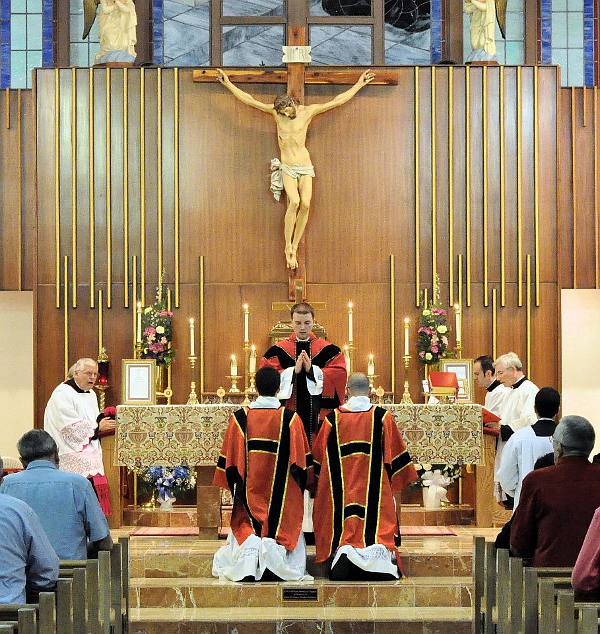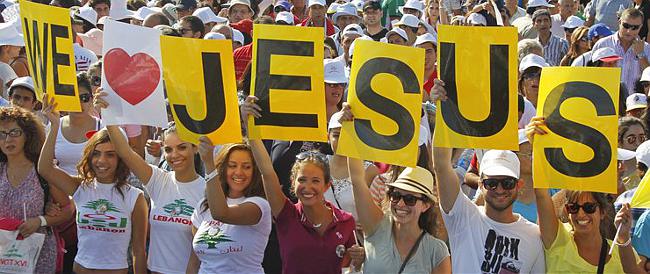En av de godt voksne og seriøse prestebloggerne i England, Fr. Tim Finigan, holdt nylig et foredrag ved the Catholic Theological Association Annual Conference, kalt «New Movements and New Media«. Der sa han bl.a. om blogging:
The rise of the Catholic blogosphere was not something engineered by Pope Benedict, though his election proved to be a focal point for many new bloggers at a time of growth. What he has done is to encourage this phenomenon and to give some fatherly guidance. Three successive annual messages for World Communications Day were devoted to the digital media. In 2009, the Holy Father spoke of how new technologies had brought about a shift in patterns of communication and human relationships. He addressed the “digital generation” encouraging the promotion of human understanding and solidarity. Remarkably he addressed the concept of Christian friendship in the context of a digital concept of “friend”, a clear reference to Facebook. Towards the end of his message, he appealed to young Catholics:
It falls, in particular, to young people, who have an almost spontaneous affinity for the new means of communication, to take on the responsibility for the evangelization of this «digital continent». Be sure to announce the Gospel to your contemporaries with enthusiasm. You know their fears and their hopes, their aspirations and their disappointments: the greatest gift you can give to them is to share with them the “Good News” of a God who became man, who suffered, died and rose again to save all people.
The following year, the Holy Father addressed priests particularly. He spoke of the way in which digital communications offer priests new possibilities for proclaiming the word of God.
The spread of multimedia communications and its rich “menu of options” might make us think it sufficient simply to be present on the Web, or to see it only as a space to be filled. Yet priests can rightly be expected to be present in the world of digital communications as faithful witnesses to the Gospel, exercising their proper role as leaders of communities which increasingly express themselves with the different “voices” provided by the digital marketplace. Priests are thus challenged to proclaim the Gospel by employing the latest generation of audiovisual resources (images, videos, animated features, blogs, websites) which, alongside traditional means, can open up broad new vistas for dialogue, evangelization and catechesis.
Since April 2006, my blog has had six and a half million page views from nearly 4 million visitors. Other priests I know have up to ten times the number of readers that I have. Even a relatively low traffic blog by a priest who simply posts his sermons each week would get in excess of 200 unique visitors per day. There is no way that we would reach that number of people by preaching in Church or even by standing on a soap box in the local shopping mall. A priest who blogs is made acutely aware of his responsibilities by the (unmanageable) correspondence that he receives from the faithful who are grateful, confused by things that have happened in their local Church, in need of prayer, or puzzled by some aspects of Catholic doctrine. Whatever criticisms we might have of individual priests’ blogs this platform is certainly a means that can be used for evangelisation.
In 2011 Pope Benedict addressed the question of the internet a third time. He spoke of a vast cultural transformation parallel to the industrial revolution. I would suggest that it is also parallel to the invention of moveable type, something especially relevant to evangelisation. In this message he addressed the dangers of “cyberspace” particularly in regard to personal authenticity. He also reaffirmed that direct personal contact can never be replaced by virtual friendships and that such contact was fundamental for the transmission of the faith. He called us back to Christ:
In the final analysis, the truth of Christ is the full and authentic response to that human desire for relationship, communion and meaning which is reflected in the immense popularity of social networks. Believers who bear witness to their most profound convictions greatly help prevent the web from becoming an instrument which depersonalizes people, attempts to manipulate them emotionally or allows those who are powerful to monopolise the opinions of others.
In these messages, Pope Benedict used his authority, which is hugely respected by many Catholic bloggers, to offer a deeper vision of social communication and to invite us to an examination of conscience which is necessary from time to time when communication is made so easy, effective and powerful.
Det engelske tidsskriftet The Tablet liker ikke blogging noe særlig, soesielt ikke konservative, katolske blogger, og skriver:
[T]he use of social media, particularly blogs and tweets, where instant reaction is coarsening debate. And it’s evident not just in politics but in religion too, particularly in comment over the same topics that cause such vitriol in politics: life and death issues, sex, marriage, gays. Friends who work at The Guardian tell me that great care has to be taken in monitoring its website whenever Catholics write opinion pieces, given the aggression of many readers’ instant responses to them.
Critics of the Church and of Catholics are not only to blame. Nasty, unChristian remarks abound within the Catholic world. No wonder one Catholic journalist says he won’t read the most vicious sites of the Catholic blogosphere any more: he views them as an occasion of sin. But what’s worrying is that Rome is apparently keen to read them too.
The Vatican itself has become adept at using new media – check out YouTube, its tweets, its websites – realising the power of these twentyfirst-century opinion formers. The word is that Vatican officials are gleaning much of their “knowledge” of the Church beyond Rome from blogs, including those that have made spite their signature dish.
If we have reached a stage when Rome’s views are shaped by bloggers’ vitriol rather than the opinions of its nuncios and its bishops, let alone sounding out the people in the pews who pray and pay, then something deeply distorted is developing. It’s certainly no way for Rome to learn to talk human. (Father Z. kommenterer dette her – svært kritisk til the Tablet.)
Jeg har selv blogget i over 7 år, har ca 200 besøk pr dag, og fått kjeft noen ganger. Personlig syns jeg nok det kan være ubehagelig å lese kommentarer i blogger, nettaviser o.l., mens innleggene/sidene selv ofte er nyttige. Jeg har sensurert en del innlegg på min egen blogg, og f.eks. er kommanterene på Vårt Lands Verdidebatt hovegrunnen til at jeg besøker denne fellesbloggen forholdsvis sjelden.




